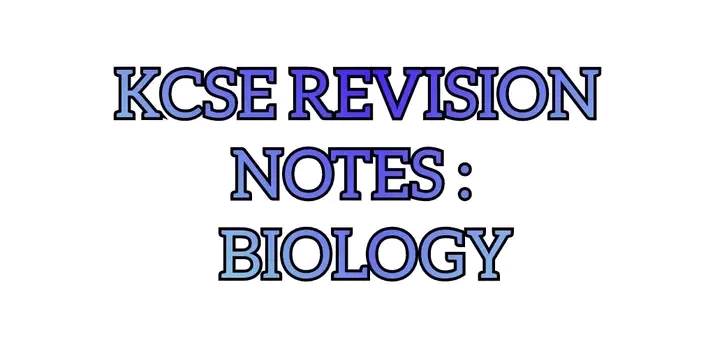Biology Form 1 Notes : Introduction To Biology
BRANCHES OF BIOLOGY
There are two main branches:
1. Botany: Study of plants
2. Zoology: Study of animals
The others include:
Ecology: Study of living things in their surroundings.
Genetics: The study of inheritance and variation.
Entomology: Study of insects
Parasitology: Study of parasites
Taxonomy: Study of classification of organisms
Microbiology: Study of microscopic organisms
Anatomy: Study of structure of cells
Cytology: Study of cells
Biochemistry: Study of chemical changes inside living organisms
Name at least six other smaller branches of biology (6 marks).
Importance of Biology
Solving environmental problems e.g. Food shortage, poor health
services, pollution, misuse of environmental resources etc
Choice of careers e.g. Medicine, Agriculture, public health,
Veterinary, Animal husbandry, Horticulture, Dentistry etc
1. Acquiring scientific skills e.g. observing, identifying, recording,
classification, measuring, analyzing, evaluating etc.
2. International cooperation e.g. Development of HIV\AIDS
vaccine, fight against severe Acute respiratory Syndrome (SARS),
fight to save ozone layer from depletion, management of resources
through international depletion.
Others
● Help on study of other subjects
● Learn what living things are made up of and their bodies work
● Acquire knowledge about plant and animal diseases and their
treatment.
3 Know the effects of our bodies on drug and substance abuse and
can kill.
● Learn about HIV\AIDS diseases and other viral diseases e.g. its
treatment—balanced diets, proper hygiene, spreading, sexual
behavior, cultural practices etc.
List five professional occupations that require the study of biology. (5
marks)
Characteristics of living things;
1. Nutrition: Process by which living things acquire and utilize
nutrients: plants photosynthesize; animals feed on already
manufactured foods.
2. Respiration: energy-producing process occurring in all the cells of
living things.
3. Gaseous Exchange: where living things take in air (oxygen) and
give out air(carbon iv oxide) across respiratory surfaces.
4. Excretion: Process by which waste or harmful materials resulting
from chemical reactions within cells of living things are eliminated.
Excess of such materials poison living things.
5. Growth and Development: Growth –is the irreversible increase in
size and Mass.—Essential for body function. Development –
Irreversible change in complexity of the structure of living things.
6. Reproduction: Process by which living things give rise to new
individuals of the same kind.
7. Irritability: Is the ability of living things to perceive changes in their
surroundings and respond to them appropriately. E.g. reaction to
changes in temperature, humidity, light, pressure and to the presence
of certain chemicals.
8. Movement: Change in position by either a part or the whole living
thing. Locomotion – Progressive change in position by the whole
living thing. In animals, movement include; swimming, walking,
running, flying. In plants, closing of leaves, folding of leaves, closing
of flowers, growing of shoots towards light etc.
Questions
1. List four uses of energy obtained from the process of respiration.
(4 marks).
2. List six characteristics of living things (6 marks).
Collection of specimens
Apparatus used
1. Sweep net: for catching flying insects.
2. Fish net: For trapping small fish and other small water animals.
3. Pooter:For sucking small animals from rock surfaces and tree
barks.
4. Bait trap: For attracting and trapping small animals e.g. rats.
5. Pitfall trap: For catching crawling animals.
6. Pair of forceps: picking up small crawling animals e.g. stinging
insects.
7. Specimen bottles: keeping collected specimens. Larger
specimens require large bottles.
8. The magnifying lens: Instrument used to enlarge objects.
Lenses are found in microscopes and the hand lens (magnifier).
Its frame is marked e.g. x8 or x10—indicating how much larger
will be the image compared to the object.
Precautions during Collection and Observation of specimens
● Collect only the number of specimens you need.
● Do not harm the specimens during the capture or collection
exercise.
● Handle dangerous or injurious specimens with care e.g. stinging
plants or insects i.e. use forceps or hand gloves.
● The teacher will immobilize highly mobile animals. (diethyl
ether, formalin, chloroform)
● Do not destroy the natural habitat of the specimens.
Practical activity 2
Practical activity 3
Comparison between plants and animals
| Plants | Animals |
| 1. Green in colour( have chlorophyll) | 1. Lack of chlorophyll thus feeds on readymade food. |
| 2. Their cells have cellulose cell walls. | 2. Cells lack cellulose cell walls. |
| 3. Respond slowly to changes in the environment. | 3. Respond quickly. |
| 4. Lack specialized excretory organs. | 4. Have complex excretory organs. |
| 5. Do not move about. | 5. Move about in search of food and water. |
| 6. Growth occurs in shoot and root tips.(apical growth) |
6.Growth occurs in all body |
 KCSE Revision Zone
KCSE Revision Zone












